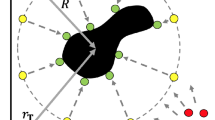Abstract
Line-follower robots are used in industry to transport materials and objects autonomously by following certain paths. These paths may be drawn lines or magnetic tapes on the floor that are detected by a sensor array. In this research, a mathematical model of the dynamics of the tracking error of a line-follower differential robot is derived. The derived mathematical form of the rate of change of the tracking error shows its dependency on the direction of the tangent of the desired path, the current direction of the robot, and the angular and linear velocities. Based on this error model and using the Lyapunov approach, a variable structure controller is designed to guarantee a stable tracking performance. In addition, it is shown how the controller parameters can be chosen based on the robot’s maximum velocities and the maximum expected angle between the robot’s linear velocity and the tangent of the path. Then, the effect of the dynamics of the robot is investigated. The introduced controller is experimentally tested using a small differential robot using two different tracks. The results show that the robot successfully followed the test tracks using different parameter settings. However, some settings give better performance than others, which are explained.















Similar content being viewed by others
References
Chandramohan S, Senthilkumaran M (2021) Intelligent automatic guided vehicle for smart manufacturing industry. Springer, Singapore
Antony M, Parameswaran M, Mathew N, SV S, Joseph J, Jacob CM (2020) Design and implementation of automatic guided vehicle for hospital application. In: 2020 5th International Conference on Communication and Electronics Systems (ICCES), pp 1031–1036. https://doi.org/10.1109/ICCES48766.2020.9137867
Nugraha MB, Ardianto PR, Darlis D (2015) Design and implementation of RFID line-follower robot system with color detection capability using fuzzy logic. In: 2015 International Conference on Control, Electronics, Renewable Energy and Communications (ICCEREC), pp 75–78. https://doi.org/10.1109/ICCEREC.2015.7337058
Aharari A, Ueda Y (2019) Low pass filter applied to color sensor of line follower robot. Procedia Comput Sci 154:693–698. https://doi.org/10.1016/j.procs.2019.06.108
Goncalves J, Pinto VH, Costa P (2019) A line follower educational mobile robot performance robustness increase using a competition as benchmark. In: 2019 6th International Conference on Control, Decision and Information Technologies (CoDIT), pp 934–939. https://doi.org/10.1109/CoDIT.2019.8820556
Kondakor A, Torcsvari Z, Nagy A, Vajk I (2018) A line tracking algorithm based on image processing. In: 2018 IEEE 12th international symposium on applied computational intelligence and informatics (SACI), pp 000039–000044. https://doi.org/10.1109/SACI.2018.8440975
Surya Prakash M, Ajay Vignesh K, Shyamsunthar J, Raman K, Senthil Raju J, Raju N (2012) Computer vision assisted line following robot. Procedia Eng 38:1764–1772. https://doi.org/10.1016/j.proeng.2012.06.215
Gomes M, Bassora L, Morandin O, Vivaldini KC (2016) PID control applied on a line-follower AGV using a RGB camera. In: 2016 IEEE 19th International Conference on Intelligent Transportation Systems (ITSC), pp 194–198. https://doi.org/10.1109/ITSC.2016.7795553
Jen F, Mai BT (2012) Building an autonomous line tracing car with PID algorithm. In: Proceedings of the 10th World Congress on Intelligent Control and Automation, pp 4478–4483. https://doi.org/10.1109/WCICA.2012.6359236
Balaji V, Balaji M, Chandrasekaran M, Khan MKAA, Elamvazuthi I (2015) Optimization of PID control for high speed line tracking robots. Procedia Comput Sci 76:147–154. https://doi.org/10.1016/j.procs.2015.12.329
Toumpa A, Kouris A, Dimeas F, Aspragathos N (2018) Control of a line following robot based on FSM estimation. IFAC-PapersOnLine 51(22):542–547. https://doi.org/10.1016/j.ifacol.2018.11.573
Glowicki M, Butkiewicz BS (2013) Autonomous line-follower with fuzzy control. 2013 Signal Processing Symposium (SPS), pp 1–6. https://doi.org/10.1109/SPS.2013.6623591
Pan Y, Li Q, Liang H, Lam H-K (2021) A novel mixed control approach for fuzzy systems via membership functions online learning policy. IEEE Trans Fuzzy Syst. https://doi.org/10.1109/TFUZZ.2021.3130201
Pan Y, Wu Y, Lam HK (2022) Security-based fuzzy control for nonlinear networked control systems with DoS attacks via a resilient event-triggered scheme. IEEE Trans Fuzzy Syst. https://doi.org/10.1109/TFUZZ.2022.3148875
Author information
Authors and Affiliations
Corresponding author
Rights and permissions
About this article
Cite this article
Asham, A.D. Mathematical analysis of a line-follower robot, a stable controller design using Lyapunov approach, and experimental tests. Int. J. Dynam. Control 11, 385–395 (2023). https://doi.org/10.1007/s40435-022-00973-x
Received:
Revised:
Accepted:
Published:
Issue Date:
DOI: https://doi.org/10.1007/s40435-022-00973-x




